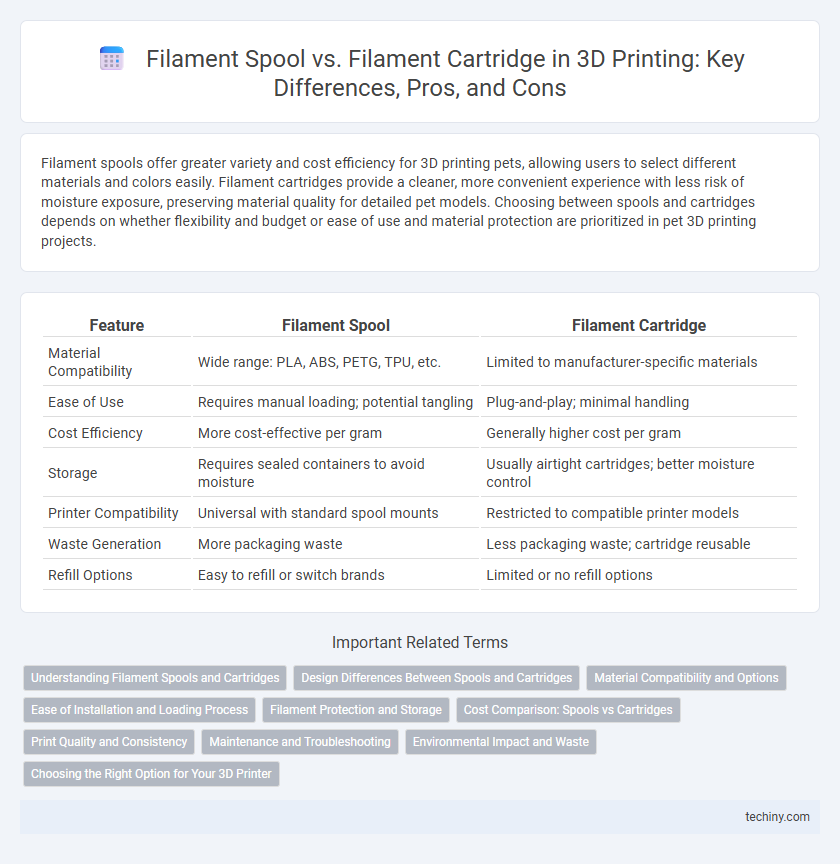Filament spools offer greater variety and cost efficiency for 3D printing pets, allowing users to select different materials and colors easily. Filament cartridges provide a cleaner, more convenient experience with less risk of moisture exposure, preserving material quality for detailed pet models. Choosing between spools and cartridges depends on whether flexibility and budget or ease of use and material protection are prioritized in pet 3D printing projects.
Table of Comparison
| Feature | Filament Spool | Filament Cartridge |
|---|---|---|
| Material Compatibility | Wide range: PLA, ABS, PETG, TPU, etc. | Limited to manufacturer-specific materials |
| Ease of Use | Requires manual loading; potential tangling | Plug-and-play; minimal handling |
| Cost Efficiency | More cost-effective per gram | Generally higher cost per gram |
| Storage | Requires sealed containers to avoid moisture | Usually airtight cartridges; better moisture control |
| Printer Compatibility | Universal with standard spool mounts | Restricted to compatible printer models |
| Waste Generation | More packaging waste | Less packaging waste; cartridge reusable |
| Refill Options | Easy to refill or switch brands | Limited or no refill options |
Understanding Filament Spools and Cartridges
Filament spools offer a traditional and widely compatible option for 3D printing, providing large quantities of material wound on a reel that enables continuous printing and easy inspection of remaining filament. Filament cartridges are enclosed in secure, often sealed containers designed to protect material from moisture and contamination, enhancing print consistency and reducing filament waste. Choosing between spools and cartridges depends on factors like printer compatibility, storage conditions, and desired print quality, with cartridges typically preferred for high-precision applications and spools favored for cost-efficiency and flexibility.
Design Differences Between Spools and Cartridges
Filament spools feature an open design with filament wound around a central hub, allowing easy manual handling and visibility of remaining material. Filament cartridges are enclosed in protective casing, which safeguards the filament from moisture and dust while often integrating with specific 3D printer models for streamlined loading. This design distinction significantly impacts filament preservation, user convenience, and compatibility with various 3D printing systems.
Material Compatibility and Options
Filament spools offer broad material compatibility, supporting a wide range of filaments including PLA, ABS, PETG, TPU, and specialty materials like carbon fiber and wood composites. Filament cartridges are typically designed for specific printers and may have limited material options, often constrained to manufacturer-approved types to ensure optimal performance. Choosing between spools and cartridges depends on the need for material variety and printer compatibility, with spools providing more flexibility for experimental or diverse printing projects.
Ease of Installation and Loading Process
Filament spools offer a straightforward installation process by simply placing the spool on a holder and manually feeding the filament into the extruder, ideal for users who prefer hands-on setup and quick filament changes. Filament cartridges, enclosed in a compact casing compatible with specific printers, streamline the loading process by automatically feeding filament, reducing handling errors and minimizing exposure to dust and moisture. While cartridges enhance convenience and cleanliness, spools provide greater versatility and visibility of remaining filament, appealing to experienced users prioritizing control and cost efficiency.
Filament Protection and Storage
Filament spools provide open-air storage that exposes filament to moisture and dust, risking print quality degradation without proper sealing or climate control. Filament cartridges offer enclosed protection with airtight, humidity-resistant packaging, maintaining filament integrity and preventing brittleness over time. Choosing cartridges enhances filament longevity and print consistency by minimizing environmental exposure and contamination.
Cost Comparison: Spools vs Cartridges
Filament spools generally offer a lower cost per gram of material compared to filament cartridges, making them more economical for large-volume 3D printing projects. Spools also provide greater compatibility with a variety of 3D printers, reducing the need for brand-specific purchases that often increase cartridge prices. While cartridges offer convenience and ease of use with pre-loaded material, the overall expense tends to be higher due to proprietary packaging and limited refill options.
Print Quality and Consistency
Filament cartridges deliver enhanced print quality and consistency by providing a sealed environment that protects filament from moisture and dust, reducing printing defects and nozzle clogs. In contrast, traditional filament spools are more exposed, often requiring additional storage measures to maintain filament integrity, which can impact layer adhesion and surface finish. Consistent filament diameter and moisture control in cartridges contribute significantly to reliable extrusion and smoother prints.
Maintenance and Troubleshooting
Filament spools require regular monitoring for tangles and dust buildup to prevent print failures and nozzle clogs, demanding routine cleaning and careful storage. Filament cartridges offer enclosed filament protection, reducing exposure to moisture and debris, which simplifies maintenance but may require specific printer compatibility checks during troubleshooting. Both formats necessitate inspecting the filament path and extruder for jams, while cartridges typically streamline filament replacement and reduce downtime compared to traditional spools.
Environmental Impact and Waste
Filament spools generate significant plastic waste due to their large, non-recyclable hubs, contributing to landfill accumulation and environmental pollution. Filament cartridges, designed with reusable or recyclable materials, reduce waste by allowing resin refills without discarding the entire container. Choosing cartridges over traditional spools supports sustainable 3D printing practices by minimizing plastic consumption and promoting eco-friendly material lifecycle management.
Choosing the Right Option for Your 3D Printer
Filament spools offer versatility with a wide range of materials and colors, ideal for users seeking customization and cost efficiency in 3D printing. Filament cartridges provide convenience and reduced risk of contamination, often featuring airtight packaging and integrated chip technology for printer compatibility. Selecting the right option depends on your printer's specifications, printing frequency, and desired material control to ensure optimal print quality and reliability.
Filament Spool vs Filament Cartridge Infographic

 techiny.com
techiny.com